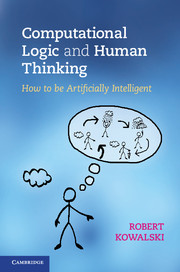Book contents
- Frontmatter
- Contents
- Preface
- Summary and plan of the book
- Introduction
- 1 Logic on the Underground
- 2 The psychology of logic
- 3 The fox and the crow
- 4 Search
- 5 Negation as failure
- 6 How to become a British Citizen
- 7 The louse and the Mars explorer
- 8 Maintenance goals as the driving force of life
- 9 The meaning of life
- 10 Abduction
- 11 The Prisoner’s Dilemma
- 12 Motivations matter
- 13 The changing world
- 14 Logic and objects
- 15 Biconditionals
- 16 Computational Logic and the selection task
- 17 Meta-logic
- Conclusions of the book
- A1 The syntax of logical form
- A2 Truth
- A3 Forward and backward reasoning
- A4 Minimal models and negation
- A5 The resolution rule
- A6 The logic of abductive logic programming
- References
- Index
16 - Computational Logic and the selection task
Published online by Cambridge University Press: 07 September 2011
- Frontmatter
- Contents
- Preface
- Summary and plan of the book
- Introduction
- 1 Logic on the Underground
- 2 The psychology of logic
- 3 The fox and the crow
- 4 Search
- 5 Negation as failure
- 6 How to become a British Citizen
- 7 The louse and the Mars explorer
- 8 Maintenance goals as the driving force of life
- 9 The meaning of life
- 10 Abduction
- 11 The Prisoner’s Dilemma
- 12 Motivations matter
- 13 The changing world
- 14 Logic and objects
- 15 Biconditionals
- 16 Computational Logic and the selection task
- 17 Meta-logic
- Conclusions of the book
- A1 The syntax of logical form
- A2 Truth
- A3 Forward and backward reasoning
- A4 Minimal models and negation
- A5 The resolution rule
- A6 The logic of abductive logic programming
- References
- Index
Summary
In Chapter 2, we saw that psychological studies of the selection task have been used to attack the view that human thinking involves logical reasoning, and to support the claim that thinking uses specialised algorithms instead. I argued that these attacks fail to appreciate the relationship between logic and algorithms, as expressed by the equation:
specialised algorithm =
specialised knowledge + general-purpose reasoning.
Specialised knowledge can be expressed in logical form, and general-purpose reasoning can be understood largely in terms of forward and backward reasoning embedded in an observe–think–decide–act agent cycle.
I also argued that many of the studies that are critical of the value of logic in human thinking fail to distinguish between the problem of understanding natural-language sentences and the problem of reasoning with logical forms. This distinction and the relationship between them can also be expressed by an equation:
natural language understanding =
translation into logical form + logical reasoning.
We saw that even natural-language sentences already in seemingly logical form need to be interpreted, in order to determine, for example, whether they are missing any conditions, or whether they might be the converse of their intended meaning. Because of the need to perform this interpretation, readers typically use their own background goals and beliefs, to help them identify the intended logical form of the natural-language problem statement.
Information
- Type
- Chapter
- Information
- Computational Logic and Human ThinkingHow to Be Artificially Intelligent, pp. 198 - 212Publisher: Cambridge University PressPrint publication year: 2011
